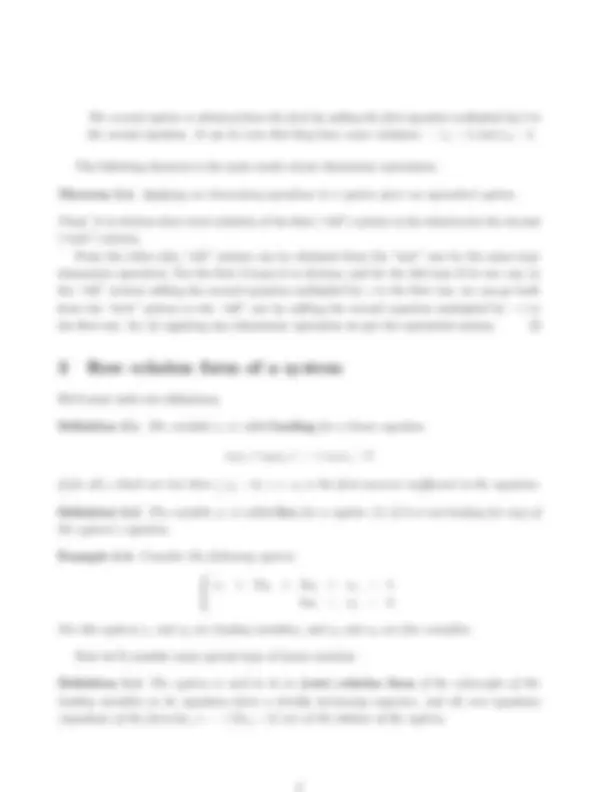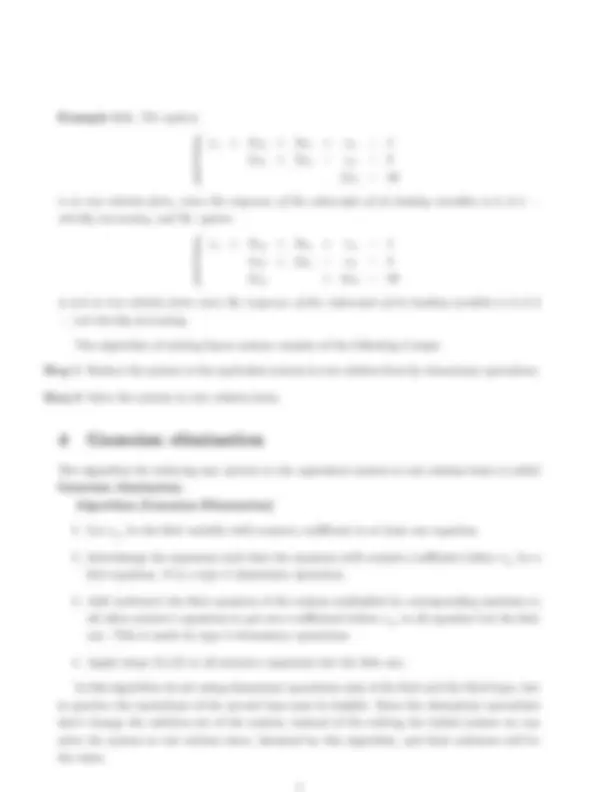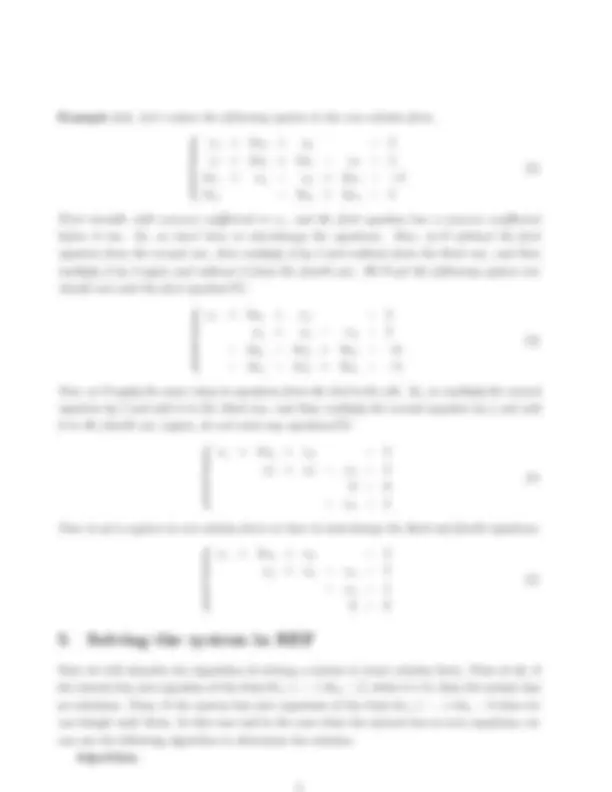





Study with the several resources on Docsity

Earn points by helping other students or get them with a premium plan


Prepare for your exams
Study with the several resources on Docsity

Earn points to download
Earn points by helping other students or get them with a premium plan
Community
Ask the community for help and clear up your study doubts
Discover the best universities in your country according to Docsity users
Free resources
Download our free guides on studying techniques, anxiety management strategies, and thesis advice from Docsity tutors
An introduction to linear systems, their definitions, and methods for solving them using elementary operations and gaussian elimination. It covers the concepts of leading variables, free variables, row echelon form, and the steps to reduce a system to this form. The document also includes examples and an explanation of the back substitution algorithm.
Typology: Study notes
1 / 6

This page cannot be seen from the preview
Don't miss anything!




This lecture we’re going to speak about the most important and boring part of linear algebra — about general linear systems — we will learn how to solve and analyze them.
Definition 1.1. Linear system is a bunch of linear equations considered together:
a 11 x 1 + a 12 x 2 + · · · + a 1 nxn = b 1 a 21 x 1 + a 22 x 2 + · · · + a 2 nxn = b 2
... am 1 x 1 + am 2 x 2 + · · · + amnxn = bm
Here we have again 3 types of letters: xi’s are variables which have to be determined, letter aij represents the coefficient in the i-th equation before the variable xj , and letter bi is the constant term in the i-th equation. Both aij ’s and bi’s are given numbers. The solution of the system is an n-tuple of numbers such that it is a solution of each of the system’s equation. To solve the system means to find a set of all its solutions, i.e. solution set.
Definition 1.2. The systems are called equivalent if they have the same solution sets. In other words, two systems are equivalent if any solution of the first system is a solution for the second system and any solution of the second system is a solution for the first system.
The following three operations can be applied to any linear system to get an equivalent system. They are called elementary operations.
Example 2.1. Let’s consider 2 systems: { x 1 + 2x 2 = 4 2 x 1 − x 2 = 3
and { 2 x 1 − x 2 = 3 x 1 + 2x 2 = 4
The second system is got from the first by interchanging its equations. It is obvious that they have same solutions — x 1 = 2 and x 2 = 1.
Example 2.2. Let’s consider 2 systems: { x 1 + 2x 2 = 4 2 x 1 − x 2 = 3
and { 2 x 1 + 4x 2 = 8 2 x 1 − x 2 = 3 The second system is obtained from the first by multiplying the first equation by 2. It is obvious that they have same solutions — x 1 = 2 and x 2 = 1.
Example 2.3. Let’s consider 2 systems: { x 1 + 2x 2 = 4 2 x 1 − x 2 = 3
and { x 1 + 2x 2 = 4 4 x 1 + 3x 2 = 11
Example 3.5. The system
x 1 + 2 x 2 + 3 x 3 + x 4 = 4 5 x 2 + 2 x 3 − x 4 = 3 2 x 4 = 10 is in row echelon form, since the sequence of the subscripts of its leading variables is 1 , 2 , 4 — strictly increasing, and the system
x 1 + 2 x 2 + 3 x 3 + x 4 = 4 5 x 2 + 2 x 3 − x 4 = 3 3 x 2 + 2 x 4 = 10 is not in row echelon form since the sequence of the subscripts of its leading variables is 1 , 2 , 2 — not strictly increasing. The algorithm of solving linear system consists of the following 2 steps:
Step 1 Reduce the system to the equivalent system in row echelon form by elementary operations.
Step 2 Solve the system in row echelon form.
4 Gaussian elimination
The algorithm for reducing any system to the equivalent system in row echelon form is called Gaussian elimination. Algorithm [Gaussian Elimination]
Example 4.1. Let’s reduce the following system to the row echelon form.
x 1 + 2 x 2 + x 3 = 2 x 1 + 3 x 2 + 2 x 3 − x 4 = 4 2 x 1 + x 2 − x 3 + 3 x 4 = − 2 2 x 1 − 2 x 3 + 3 x 4 = 1
First variable with nonzero coefficient is x 1 , and the first equation has a nonzero coefficient before it too. So, we don’t have to interchange the equations. Now, we’ll subtract the first equation from the second one, then multiply it by 2 and subtract from the third one, and then multiply it by 2 again and subtract it from the fourth one. We’ll get the following system (we should not omit the first equation!!!):
x 1 + 2 x 2 + x 3 = 2 x 2 + x 3 − x 4 = 2 − 3 x 2 − 3 x 3 + 3 x 4 = − 6 − 4 x 2 − 4 x 3 + 3 x 4 = − 3
Now, we’ll apply the same steps to equations from the 2nd to the 4th. So, we multiply the second equation by 3 and add it to the third one, and than multiply the second equation by 4 and add it to the fourth one (again, do not omit any equations!!!):
x 1 + 2 x 2 + x 3 = 2 x 2 + x 3 − x 4 = 2 0 = 0 − x 4 = 5
Now, to get a system in row echelon form we have to interchange the third and fourth equations:
x 1 + 2 x 2 + x 3 = 2 x 2 + x 3 − x 4 = 2 − x 4 = 5 0 = 0
5 Solving the system in REF
Next we will describe the algorithm of solving a system in (row) echelon form. First of all, if the system has zero equation of the form 0x 1 + · · · + 0xn = b, where b 6 = 0, then the system has no solutions. Than, if the system has zero equations of the form 0x 1 + · · · + 0xn = 0 then we can simply omit them. In this case and in the case when the system has no zero equations, we can use the following algorithm to determine the solution. Algorithm.